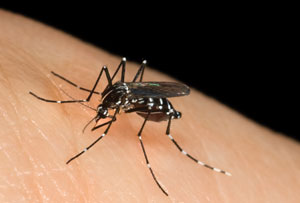LSU researcher aims to predict emerging viruses
An associate professor at Louisiana State University School of Veterinary Medicine has received a multimillion-dollar award from the National Institutes of Health to lead a project to investigate and predict the transmission and potential for emergence of various arthropodborne viruses, particularly dengue virus.

Christopher Mores, ScD, associate professor in the Department of Pathobiological Sciences, is the principal investigator for a project titled "Predicting vector-borne virus transmission and emergence potential." The award will provide more than $3 million over the next five years for Dr. Mores and his consortium of researchers from LSU, Tulane University, and the University of New Mexico.
As part of the award, the researchers will join the NIH's National Institute of General Medical Sciences' Models of Infectious Disease Agent Study. This research network uses computational modeling techniques to better understand the spread of contagious diseases and to calculate the potential impact of public health measures.
The aim of Dr. Mores' project is to use mathematic modeling to more accurately forecast the transmission of dengue and other viral diseases, specifically in the U.S. Of particular interest are the factors that affect transmission in vector and human populations separately, and then how these factors combine to affect overall transmission of the virus, according to an LSU press release.
"Most of the dengue cases detected in the U.S. are imported, but the number of locally acquired cases is increasing. The entire Gulf Coast is at potential risk from dengue," Dr. Mores said in the release.
He said the virus is being brought in by travelers and is becoming established in local mosquito populations. In 2009, for example, local transmission of dengue was seen in the U.S. when people vacationing in Key West became infected after being bitten by local mosquitoes. Also, in 2010, Puerto Rico witnessed an extensive outbreak with more than 10,000 cases reported. The vector density needed to achieve transmission is low, so it doesn't take many infected mosquitoes to trigger an outbreak, Dr. Mores said.
His team will first concentrate on establishing the factors that drive the spread of dengue and on assessing the impact of community-based and international intervention strategies, according to the release. Team members will then seek to apply their findings to modeling the spread of other insectborne diseases. These include chikungunya and Rift Valley fever, which also have the potential to expand into the southern U.S. via infected travelers, animals, and vectors, and to become entrenched in local mosquito populations.